
What is fitness? The first definition of fitness is: “health”. Health is defined as “the general condition of the body or mind with reference to soundness and vigor: good health; poor health.”
So to explore the future of fitness, we need to know how technology will impact our health. According to famed futurist Ray Kurzweil, within this century we will have blood-cell-sized nanobots, swimming through our bloodstreams keeping us healthy by zapping cancer, correcting DNA errors, removing toxins, extending our memories and eating up brownies before they hit our thighs. And we’ll have chips in our bodies that will transmit our personal health data to and from devices and our brain.
The path to the future of fitness relies on massive data aggregation, social elements and convenience. While it’s fascinating to track your weight, your height, BMI, running patterns and your caloric intake, future intelligence will rely on much more than that. It will know the history of your injuries, your genetics, your complete biometric data and not just about your activity today but also how external conditions play their part such as your geographic location, weather patterns, your social graph and what music you’re listening to. In the future, you’ll be able to correlate across all these different categories for a truly, holistic report on your health. So let’s meet the companies taking us there.
Let the Fitness Data Aggregation Begin

RunKeeper
RunKeeper CEO Jason Jacobs grew up playing team sports like hockey, lacrosse and baseball and it wasn’t until he graduated from college when he started thinking about fitness as something other than a sport. Now, in addition to running one of Boston’s most successful startups, he runs 5-7 miles every day and hits the gym 3 times a week. Before he launched RunKeeper, the Babson college grad says:
“I always knew I wanted to build something big and beautiful and to make my mark on the world. I was busy searching around for what that would be, evaluating different ideas in different domains. I was training for a marathon at the time to channel these pent up ideas and kept asking myself, ‘What am I really passionate about?’ It was staring me in the face. I saw the tools I needed, I knew the space, and the more I dug in, I saw there was something really big here. As soon as those stars aligned I had a hypothesis for where I’d start: the intersection of fitness and data.”
Looking at Nike Plus, Jacobs was inspired but thought, “Why is this only being done around one pedometer, around one brand of shoes for one sport?” Seeing the promise of sensor technology, he asked, “Why isn’t someone tying this all together? Jacobs launched RunKeeper in August 2008, and it was one of the first 200 iOS apps in the App store. RunKeeper was also one of the first companies with a freemium model, which allowed them to be cash positive from an early stage. The team raised a $1.1 million Series A round in November 2010.
“People assumed the app was always the vision for our business, but even before the smartphone was on the radar, we knew we wanted to build a system to tie all health categories together, something to engage users, that could spread organically and virally. If we had come out and said, ‘We’re aggregating the world’s health information from the start, nobody would’ve shown up,” says Jacobs.
Runkeeper now has 6 million registered users, which use its platform to track all of their stats from dozens of devices and applications like FitBit, Zeo, Wahoo, Withings and of course, the Runkeeper app. Check out my user profile here to see it in action. In June, Jacobs announced that RunKeeper’s open API would enable 3rd party apps to be built on top of an unprecedented amount of correlated health data; what he calls “The Health Graph” much like Facebook’s “Social Graph”. Just this week, Runkeeper unveiled Runkeeper races, which allow users to search for races to participate in and keep track of their past, present and future races.

“I use RunKeeper because it does something for me that I clearly couldn’t do on my own very efficiently– track distance and time. Aside from RunKeeper, I don’t use anything. I suppose I should, but the thing is, most fitness people are very into routines. By definition, they’re creatures of habit–so I think it’s probably really hard to get them to switch over and use new things,” says New York City VC Charlie O’Donnell of First Round Capital.
According to Jacobs, about 2-3 years into the future, you won’t be hitting a button to track anything, it will be automatic. You take a sip of water and the system knows. Data collection will be passive, unobtrusive and free. All the intelligence will be ‘under the hood.’ Taking care of your health will be like listening to turn by turn TomTom directions. “Time to wake up. Drink a glass of water. Time to sleep. You’re done working out. You ate a donut. Redirecting.”
Will we need personal trainers in the future? “I don’t think they’ll go away because there will always be people who prefer the ‘human touch’ but the machines will get better at coaching. While the best personal trainers are giving advice based on dozens, or perhaps hundreds of clients, machine will have access to the experience of thousands if not billions of clients,” predicts Jacobs.
Check out our video interview with Jacobs here for more of his Future of Fitness predictions:
23 and Me
 23andMe is a personal genetics company co-founded by Anne Wojcicki, the wife of Google’s Sergey Brin. I signed up a year ago and paid $99.99, plus $5.00 per month for the subscription. Deals for the service pop up quite often so don’t pay the full price. It’s easy to use, just spit in a tube and mail it off and about 6 weeks later the test results arrive via e-mail and in an easy to download PDF format.
23andMe is a personal genetics company co-founded by Anne Wojcicki, the wife of Google’s Sergey Brin. I signed up a year ago and paid $99.99, plus $5.00 per month for the subscription. Deals for the service pop up quite often so don’t pay the full price. It’s easy to use, just spit in a tube and mail it off and about 6 weeks later the test results arrive via e-mail and in an easy to download PDF format.
The test provides insight into your ancestral origins; traits, from hair quality to muscle performance; risk factors for 93 diseases; and your predicted response to drugs, from blood thinners to coffee. You are then given a log-in where you can explore new genetic data as it comes in and how it relates to you. The technology confirms facts I already knew about myself like “I have brown hair,” to as random, yet still true as “I have moderately higher odds of smelling asparagus in my urine.” It then reported things I didn’t know about myself, like “I have about an 80% chance of not being able to taste certain bitter flavors.” This is not a good evolutionary sign.
Every two weeks or so, I still receive new personal information from 23andme. The more people who submit their DNA, the better the overall results will be for everyone. Let the DNA data collection begin.
Wahoo
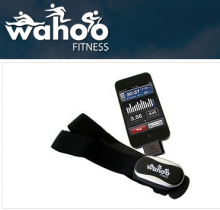 “In the future, you’ll be able to instantly share all of your biometric data with doctors and insurance companies so you can receive a discount for good health,” says Chip Hawkins, the founder and CEO of Wahoo Fitness.
“In the future, you’ll be able to instantly share all of your biometric data with doctors and insurance companies so you can receive a discount for good health,” says Chip Hawkins, the founder and CEO of Wahoo Fitness.
Hawkins, a self-proclaimed “gadget and health nut” started Wahoo Fitness 2 years ago in Atlanta, GA. The company makes products that wirelessly connect your iPhone to your favorite fitness sensors such as heart rate straps and stride sensors. They make two primary devices: a key that plugs into your iPhone for running and a waterproof case for cycling. Wahoo connects with over 60 applications including RunKeeper, Runmeter and Training Peaks.
Hawkins says in the next year or two we will see calorimeter devices that you can wear on your upper arm to measure your caloric intake. The band works by measuring heat flux, i.e. the energy that’s leaving your body.
Zeo
 “Sleep is one of the most important aspects of your health and wellness. Everything is related and ties back to sleep,” says Zeo’s CEO Ben Rubin.
“Sleep is one of the most important aspects of your health and wellness. Everything is related and ties back to sleep,” says Zeo’s CEO Ben Rubin.
While there are less clunky options for measuring your sleep like WakeMate, Zeo‘s headband (pictured right) actually works and is far more accurate. “This theme is true for a variety of devices- the bigger and clunkier they are, the more accurate they are, but we all know this will change,” says RunKeeper’s Jason Jacobs.
Zeo monitors your brain waves while you’re sleeping to produce a “ZQ score”, which is a measure of the quantity and quality of your sleep each night. It measures both your deep and REM sleep, how many times you’re woken up in the night and then wakes you up at the appropriate time. Rubin says they’re in the business of sleep management so the platform includes a full suite of solutions for getting better sleep. It lets you compare your sleep data to others, so you can make decisions like buying a new mattress, cutting out the caffeine, getting your husband to stop snoring or kicking the dog out of bed.
Rubin recommends the Philips Wake Up Light, which wakes you up in a more natural way by emitting light that increases gradually and simulates the sunrise. He also recommends F.lux, which makes the color of your computer’s display adapt to the time of day, warm at night and sunlight during the day. And what does the future hold? Rubin predicts:
“5-7 years into the future, you’ll walk into your bathroom and your temperature and heart rate will be measured. Your urine, analyzed. How tired you look will be saved in your mirror. All of this will be done with minimal intervention. And when we have all that data, people will build smart analytics layers on top of it, so you’ll receive an email that says: ‘We’ve noticed your sleep quality sucks. We think it’s because you’ve been on your computer til 1AM every night. And have you been sticking to your diet? Your urine samples are registering a high PH level.’ The future of fitness will be all about sensor technology and smart algorithms.”
Withings
CEO Cédric Hutchings started Withings, a French company in 2008 with a simple concept: “We revisit devices you already know like the body scale and blood pressure monitor and connect them to the Internet,” says Hutchings. “We do this first, to simplify the object’s interface and second, to enrich the services and enhance the features.”
The Withings WiFi body scale measures weight, body fat and lean mass. Set up takes 5 minutes, then you just step on the scale and voilá! Your measurements are sent to your web or mobile account.
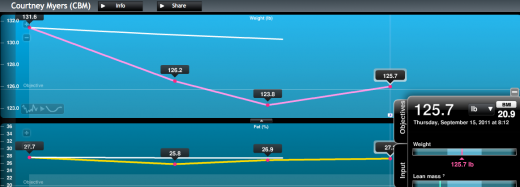
The best thing about all of these devices, particularly Withings, is that it tracks your data effortlessly without adding a new routine like having to manually store data. By making it so easy to monitor these data points, it’s easier to motivate yourself to make micro-decisions like deciding to walk back home instead of driving, taking the stairs or splitting a dessert. Withings works with a multitude of devices and applications including RunKeeper, FitBit and Zeo. Check out this full list of partnerships.
Runmeter
 Similar in functionality to RunKeeper’s app, Runmeter is an iPhone centric platform that pushes your GPS tracked workouts out to social networks and enables realtime feedback. So let’s say you push out this tweet or Facebook post: “Just started a run on Runmeter”. When someone replies to the post with “Awesome job!” You’ll hear that feedback within minutes in your earbuds. Hearing a friend of yours say, “Go Faster” will get your legs kicking faster.
Similar in functionality to RunKeeper’s app, Runmeter is an iPhone centric platform that pushes your GPS tracked workouts out to social networks and enables realtime feedback. So let’s say you push out this tweet or Facebook post: “Just started a run on Runmeter”. When someone replies to the post with “Awesome job!” You’ll hear that feedback within minutes in your earbuds. Hearing a friend of yours say, “Go Faster” will get your legs kicking faster.
Runmeter has gone to the max in terms of features, functionality and ease of use with the iPhone. In comparison to RunKeeper, which is free, the Runmeter app costs $4.99 in the app store. While Runmeter’s app is slightly more sophisticated in terms of audio and social features, it lacks a social website. It’s all about the iPhone.
I asked Steve Kusmer, a developer for Runmeter if running with an iPhone might cause any damage to its internal parts. He said, “The iPhone is very, very rugged. The up and down motion does not affect the device at all. Of course, dropping the iPhone would be damaging, which is why we recommend using it with a fitness belt, an armband or a bike mount.”
“I believe the future of fitness is connected and realtime…Realtime is where we’ll shine beyond our competitors because we allow for support during your workout. We didn’t create a company that helps people share photographs, we are literally savings lives,” says Kusmer.
In the future, data aggregation will be the norm. We caught up with Dr. Leslie Saxon, the Executive Director of USC’s Center for Body Computing, who had this to say:
“Biological statistics will become a bigger part of sports. There is a movement in every sport toward more and deeper data collection and analytics. Sports teams want data so they can crunch the numbers and create better results on the playing field. There is technology emerging–and we’re testing and developing it at the USC Center for Body Computing–that allows us to get incredible health insight. We can use the information to protect athletes and to increase their performance. For example, we have an NFL Charities grant to study dynamic heart rate in athletes. There are now sensors that can track acceleration, perspiration, core temperature…This quickly-evolving technology will trickle down into the fitness arena.
The future of fitness will be enhanced by knowledge of what your mind and body are experiencing so that better decisions and outcomes can be obtained. It will also be really interactive. Don’t be surprised that if within the next few years you will have a sensor on your body most of the time you are exercising and that you will interact with the data being collected and that user experience will be fun. The CBC is working on that too. A prediction: the next generation will find it unusual if you do NOT record your every vital sign from birth to death.”
 UP by Jawbone
UP by Jawbone
New to the scene is Jawbone’s UP (pictured right), a wearable wristband with an application that combines tracking, analysis, social and motivational elements. It will track people’s movement, sleep patterns and nutrition 24/7 and present personalized recommendations and challenges to live a healthier life. While best known for developing bluetooth headsets and wireless speakers, the Jawbone UP will plug-in via headphone jack. We’ll be sure to get back to you with a full report when it becomes available later this year.
We did however catch up with Travis Bogard, VP of Product Management & Strategy at Jawbone, who had this to say on the future of fitness:
I think we’ll see more and more technology seamlessly integrated on and about the body. It will be functional, stylish, wearable 24/7 and…will help people measure their health and understand all of the elements that affect their health over time…With this, I think we’ll see a shift toward people thinking about health as something that is 24 hours a day, 7 days a week – not just moments when we think we’re being healthy…Tools like UP will help free us from that dedicated workout time and give us an opportunity identify and track healthy activities that we enjoy each and every day.
Travis Bogard, VP of Product Management & Strategy at Jawbone
Other monitoring devices include Garmin watches and Fitbit, by far the most popular device that tracks all of your daily activity such as calories burned, sleep quality, steps and distance. FitBit syncs with fitness programs such as LoseIt!, RunKeeper and Microsoft HealthVault.
In addition to the aforementioned, there are dozens of fitness apps you should check out including: DailyMile, Cyclemeter, GymGoal, C25K, Endomondo, , MealSnap, Runtastic, Sports Tracker and DailyBurn.
Fitness will be Gamified
Fitocracy
Fitocracy founders Brian Wang and Richard Talens used to be “really out of shape, video game addicts”. Talens was “super fat” and Wang was “super skinny”. While in college, they realized they had to make a lifestyle change and thus became “addicted to fitness”. Inspired by their experience, the two started building a new platform that tracks workouts and turns personal fitness into a social game.
Fitocracy is a fitness social network that requires you to manually enter your work-out in order to gain points and move through the system. People give each other “Props,” that are equivalent to a Facebook Like. In the future, the team will hook up with applications like Nike Plus and RunKeeper, intending to be the point aggregator that sits on top of all that aggregated data. The best thing about Fitocracy is that you can log anything, so that I can compete with people even if I’m practicing yoga and they’re lifting weights. Well, you can log almost anything…
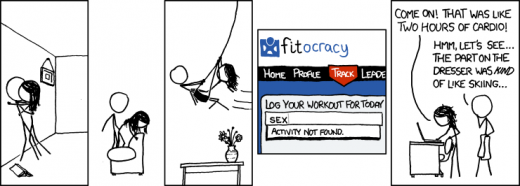
Talens, who hits the gym 3 days a week and spends all of his time doing big, heavy lifting believes fitness is inherently social and that success is best attained when we can keep each other motivated. In June, Fitocracy hit 16,000 users with 6,000 more on the waiting list. Fitocracy will be opening in Beta next month but we’ve got invites for you right here. Use the code “THENEXTWEB”.
Earndit
 I scheduled a call with Earndit founder Andres Moran last week, and it was free! If I had been using his fitness rewards platform, which he launched last September 2010, a 15 minute video chat with Moran would cost me 50 points! Call it a journalist’s perk.
I scheduled a call with Earndit founder Andres Moran last week, and it was free! If I had been using his fitness rewards platform, which he launched last September 2010, a 15 minute video chat with Moran would cost me 50 points! Call it a journalist’s perk.
Moran is the founder of Earndit, a rewards platform for fitness enthusiasts with 25,000 users. Earndit was one of RunKeeper’s first API integration partners, and its service has been a huge hit with the RunKeeper community, according to Jason Jacobs of RunKeeper. Earndit also integrates with Foursquare, Fitbit, Nike Plus, Every Trail and Garmin. I signed up for Earndit, and I’m a fan.
All this time I could’ve been earning points upon my check-ins at yoga studios and gyms! 15 points each time, 20 points if you’re the mayor. Earndit has dozens of reward partners so you can trade your points for perks like online personal trainers, retail gift cards, boxes of energy bars and gym credits.
“This space of tracking and verifiable data is blowing up for us,” says Moran. “The mere act of measuring our activities will make me more active. When you see a graphical or numerical output of your activity, you see how lazy you really are sometimes. It really prompts you to change that. It’s a slap in the face. And as they say, it’s hard to change that which you cannot measure.”
Keas
 Adam Bosworth, the former head of Google Health, has finally launched his consumer health start-up, Keas, “a game that keeps you healthy”. Users pick 3 goals a week, which can range from hitting the gym, eating less carbs to reducing stress. Keas users then receive points for accomplishing goals and taking health quizes. The social program is targeting the entreprise level and working with HR departments to become a corporate wellness program. So if your company signs up for it you can receive additional rewards, including cash.
Adam Bosworth, the former head of Google Health, has finally launched his consumer health start-up, Keas, “a game that keeps you healthy”. Users pick 3 goals a week, which can range from hitting the gym, eating less carbs to reducing stress. Keas users then receive points for accomplishing goals and taking health quizes. The social program is targeting the entreprise level and working with HR departments to become a corporate wellness program. So if your company signs up for it you can receive additional rewards, including cash.
Keas’ initial launch partners include Healthwise, Google Health, Microsoft HealthVault, Quest Diagnostics and Dr. Alan Greene. In a June interview with TechCrunch, Keas said the reason Google Health never really took off was because Google Health never asked, “What could they do that people would want?” Instead. “They basically offered a place to store data… People don’t want to store data, they want to have fun.”
Fitness is Food
Lollihop
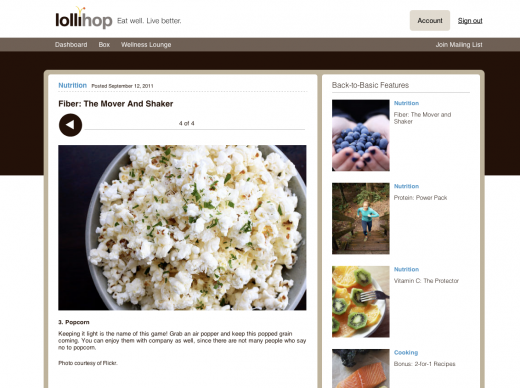
The brand new San Francisco based startup, Lollihop offers a monthly subscription service of healthy, organic snacks tied to educational online content. Founder Suzanne Xie launched the site this week to make it easier for people to eat healthy on a regular basis. Lollihop ships out healthy food much like Birchbox sends out beauty products. It’s a delightful present every month in your mailbox, a package filled with nutritional snacks from brands like Terra, Lara Bar and Kind, hand picked from ex-Whole Food buyers.
Xie has been tasting snacks for months in preparation for launch. “The first 10 snacks I tasted, I thought, ‘This is the best job ever,’ but about 50 snacks later I said, ‘OK, this is the worst job ever’,” she says laughing.
“Nutrition is a huge part of fitness,” says Xie. “If you don’t have time to work out, everything you put in your body is crucial. Today, kids consume 40% of their total calories in snack form, for adults its 30%; we’re trying to make sure those snacks are healthy.”
Coming soon, Lollihop will have a Hunch-like personalization element that will ask you simple questions like, Are you a vegetarian, vegan etc. When you wake up in the morning, how do you feel? What kind of sleep are you getting? Working with a nutritionist, Lollihop will be able to better recommend snacks and offer tailored health content to suit your needs.
Fitness is Better Health Care
ZocDoc
 ZocDoc is one of the most structurally intelligent and powerful technologies spearheading our health care revolution. ZocDoc allows patients to find nearby doctors who accept their insurance, read verified reviews written by real patients, and instantly book an appointment with a local medical professional online or via the free iPhone App. ZocDoc is a free service for patients, while doctors pay a subscription fee of $250 per doctor per month. Typically with one or two new patients, the service pays for itself. On average, doctors using ZocDoc see an additional 100 patients on a monthly basis.
ZocDoc is one of the most structurally intelligent and powerful technologies spearheading our health care revolution. ZocDoc allows patients to find nearby doctors who accept their insurance, read verified reviews written by real patients, and instantly book an appointment with a local medical professional online or via the free iPhone App. ZocDoc is a free service for patients, while doctors pay a subscription fee of $250 per doctor per month. Typically with one or two new patients, the service pays for itself. On average, doctors using ZocDoc see an additional 100 patients on a monthly basis.
“I believe patients will increasingly turn to technology for their healthcare needs. As the lines blur between mobile devices and medical devices, as telemedicine blossoms and health information continues to proliferate online, people will naturally rely on these tools. And I think they’ll find their doctors and schedule appointments online, as they can with ZocDoc, because the ease and convenience of doing so represents a real paradigm shift.”
-Cyrus Massoumi, co-founder & CEO of ZocDoc
ZocDoc is strategically based in New York City, where there are more doctors per capita than any other city in the world, according to Oliver Kharraz, MD, co-founder and COO of ZocDoc. Before expanding nationally, ZocDoc took a hyperlocal approach, making sure their product worked in downtown Manhattan. They are now set to aggressively expand across the nation in 2011 with hopes to move into international territories the following year.
Massive Health
![]() Aza Raskin, 26-year-old son of noted human-computer interface expert Jef Raskin has had a strong, laudable career thus far. He founded Humanized Inc. where he created the language-based service-oriented Enso software. In 2008, he and other Humanized employees were hired by Mozilla where he was appointed Creative Lead for Firefox. He left Mozilla late last year to begin Massive Health and tackle health issues like obesity, oronary heart disease and diabetes. Raskin will apply cognitive psychology, design principles and tighter feedback loops to our own health through Massive Health, what could be this century’s health Renaissance, “where products and services are redesigned to be responsive to human needs and considerate of human frailties.”
Aza Raskin, 26-year-old son of noted human-computer interface expert Jef Raskin has had a strong, laudable career thus far. He founded Humanized Inc. where he created the language-based service-oriented Enso software. In 2008, he and other Humanized employees were hired by Mozilla where he was appointed Creative Lead for Firefox. He left Mozilla late last year to begin Massive Health and tackle health issues like obesity, oronary heart disease and diabetes. Raskin will apply cognitive psychology, design principles and tighter feedback loops to our own health through Massive Health, what could be this century’s health Renaissance, “where products and services are redesigned to be responsive to human needs and considerate of human frailties.”
While Massive Health is still in its early stages, Raskin writes, “Why is it that we live surrounded by beautiful technology, but as soon as we get sick we’re left out in the cold? We’re working to fix that. We believe that people should be treated like people, not patients.”
How to live forever
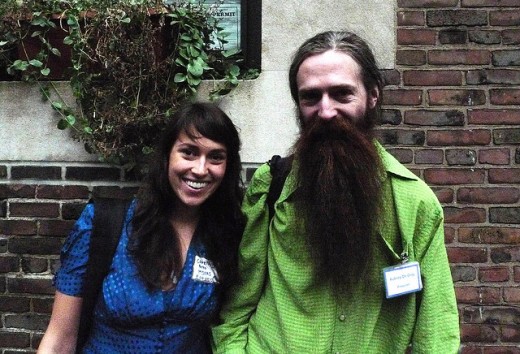
To some life extensionists, experimental gerontologists, longevists, or whatever you want to call them, people like Cambridge professor Aubrey deGray (pictured above at the 2009 Singularity Summit in NYC), believe the idea of living forever is a real biological possibility…and we’re not talking about cryonics or mind uploads.
The Methuselarity, (named after the Methuselarity flies) is commonly defined as the point where we achieve the “Longevity Escape Velocity” in the rate of progress of our anti-aging efforts. DeGray identifies aging as a problem of pathology and metabolism. After seeing a great amount of success with life extension in Methuselarity flies, deGray believes that by experimenting with calorie restriction to extend our metabolism, cell therapies to combat cell atrophy and genetic stimulations, we will be able to extend our natural lifespan by 30 years very soon, but one day we will be able to live forever. He also believes that once we begin to extend our lifespans, the ability to do so will occur at an exponential rate. For example, he believes that the first 1,000 year old is probably less than 20 years younger than the first 150-year-old and that the first 10 to the N year old is probably less than 2 years younger than the first 1,000 year old.
Last year, the MacArthur Research Network on an Aging Society released a study that said Americans living in the next 40 years will be much older than our government’s current predictions. The study not only brings up the topic of length of life, but quality of life. Dr. Steven Joyal, Vice President of Science and Medical Affairs for the Life Extension Foundation, the largest non-profit organization engaged in cutting-edge research to enhance human health says,
We are at the forefront of longevity revolution. Advancements in nanotechnology, gene therapy, artificial intelligence, and stem cell research will enable infants born today to be as functional and productive when they are one hundred and twenty years of age as people aged twenty or thirty today.
In a study by Stanford University researchers learned that maintaining an active lifestyle will add 16 years to your active life. That’s 16 years of productivity and healthy joy that might have been spent dealing with disabilities, heart issues, diabetes, etc. The bottom line is that understanding and prioritizing your health is crucial to a balanced lifestyle, whether it’s running, biking, swimming, yoga, eating right, taking long walks or just daily meditation.
Moving forward starts with data aggregation and awareness to better understand the health of humanity. In 2-3 years time, we will layer technology and smart algorithms to enable us to make smarter choices more easily. While you might feel uncomfortable about sharing massive amounts of your personal data, think of it like this: In sharing ourselves and our data, we become vulnerable, yes, but it’s allowing us to form a human community once again.
 Linkedin founder Reid Hoffman is noted for his theories surrounding Web 3.0, which combine our real identities with the massive amounts of active and passive data we are generating. Amazon, for example, can make smart recommendations to you based on what you buy and what people with similar shopping experiences buy. Now, imagine a system that operates like that around your health that will make the world healthier as more aspects of our lives are tied into the platform.
Linkedin founder Reid Hoffman is noted for his theories surrounding Web 3.0, which combine our real identities with the massive amounts of active and passive data we are generating. Amazon, for example, can make smart recommendations to you based on what you buy and what people with similar shopping experiences buy. Now, imagine a system that operates like that around your health that will make the world healthier as more aspects of our lives are tied into the platform.
Today you are more aware. Until we reach the Methuselarity, or figure out a way to live forever by technological means, you’ve got one and a half billion heartbeats on this Earth. Treat them well.
Need a little inspiration? Watch these: 9 Inspiring Videos about Health and Fitness and check out this sweet Spotify Running playlist I’ve built, which I’d love you to add to.
Image credit: Shutterstock/stryjek/Perov Stanislav/Yuganov Konstantin/Yaruta Igor/Yellowj
Get the TNW newsletter
Get the most important tech news in your inbox each week.






